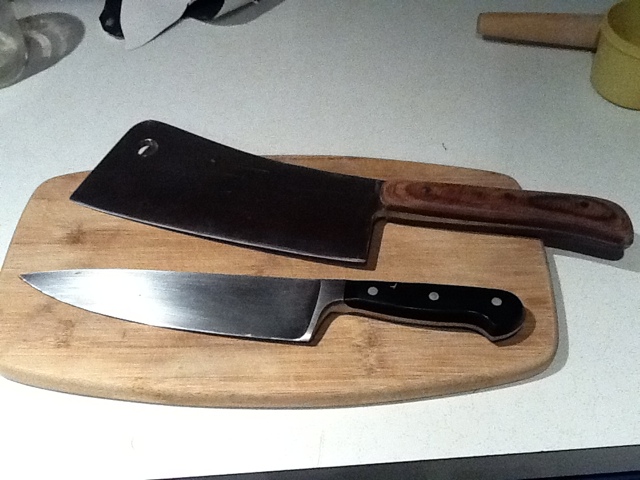It has been a few years since I have done any knife making. It is a hobby that I have always loved and have been doing since I was in middle school. I tend to cycle hobbies and will work exclusively in one medium for a while before moving to another. I have a few knife projects to work on this summer, but have only made one knife in the past five years. To get back into the swing of things I decided to tackle a restoration project.
Doing a restoration would allow me to brush up and practice my rusty skills on a rusty knife. The project is a big, old, cleaver.
My maternal Grandparents ran a store that included a meat counter. After they passed a few knives found their way to our house. The one I remember most was a slicer whose blade had been sharpened so many times it was half gone. The other was a big cleaver that was covered in rust and had most of the handle missing. the remaining wood was wrapped with tape of some kind. I wasn’t sure if that was to keep the handle from falling off or for grip. It sat in my parents garage for as long as I remember. Sometimes us kids would use it as a hatchet, and it worked pretty well. A year or two ago I stumbled on it and thought that it would be nice to restore it.
The steel was pitted pretty badly from the rust and it would take a long time to grind away enough steel to remove it completely. I decided to clean it up…most of the way. The knife is old and has history and I wanted to keep it that way. If I made it useable, but not new looking people would see it and know that it has a story. I removed the rust, but left some of the pitting. The blade is defiantly not stainless steel. While grinding a water bucked it used to cool the knife. One afternoon I was working on it and noticed it was rusting where I had ground 30 minutes ago. Rust never sleeps. It also appears to be heat treated harder along the edge and softer in the spine and handle. I noticed it ground differently, leaving slightly different textures where it was harder of softer.
For the handle I used walnut Dymondwood to keep the original look and didn’t polish it so it has a worn and used look to it. Dymondwood is really cool stuff that I have used on many knives before. It is great for when you want the look of wood, but zero work to maintain. Basically it is wood veneer and resin composite plywood. It is dense and looks good; it can be finished to any level of polish using sandpaper or a buffing wheel and requires no sealing or oiling. Perfect stuff for a kitchen knife.
I didn’t spend too much time on the cleaver, but it was enough to get my knife skills polished (or honed, either pun works). It came out well. I got a small crack in the handle, but it adds to the character of a well used and loved knife. I don’t think I will need to use it that often, but will keep it around as a family heirloom. I am also guessing that having it hanging in the kitchen will prompt questions and stories.
The knife is huge tipping the scales at 2lbs. 2 3/8oz. To get a sense of just how massive it is here it is next to a big chef knife.
